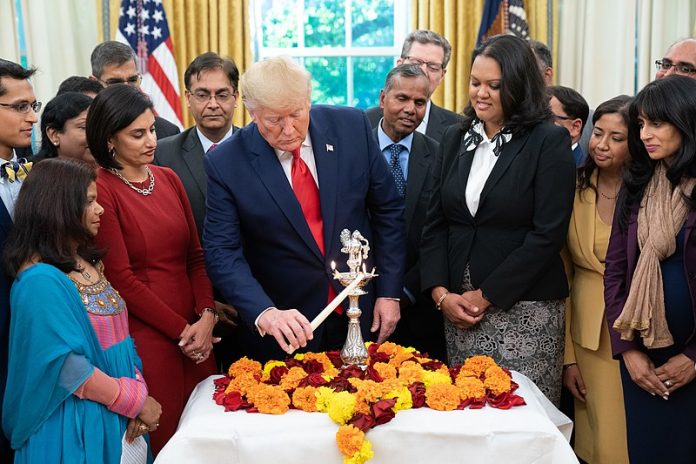With less than a month away from the election results being declared in the United States, both the Democratic and Republican campaign trail have been gathering steam. While the world watches on with much enthusiasm at one of the most consequential events this year, both the Democrats and Republicans have been concentrating efforts to woo Indian-American voters. Indicators pointing to the importance of the community during election time is exemplified by President Donald Trump spending a large sum of money on ads targeting Indian-American voters, as well as Joe Biden releasing digital ads in 14 Indian languages in September.
Tracing the Prominence of the Indian Diaspora in the U.S.
Perhaps the prevalent question lies in what propelled Indian-American voters to be an essential target group for campaigns during this pivotal time? To trace the importance of the community in the U.S., one must look at the evolution of the diaspora in the past decade and how it has become one of the key deciding factors in turning votes. Indian-Americans are the second largest group among Asians in the U.S. and have assumed positions in traditionally powerful domains such as the judicial system, Ivy League institutions and politics. The Indian community has undoubtedly seen a rapid growth since the 19th and 20th century. The earliest Indian immigrants were Punjabi farmers who gradually set the ball rolling for other Indians to migrate to the U.S. and become one of the wealthiest communities in the nation. Moreover, the overall impression of the Indian-American community has been positive for the most part; they are seen as hard working and law-abiding citizens, and an ethnic community that embodies values of what a model minority ought to be in the U.S.
In retrospect, until the 2000s there wasn’t much chatter about the community’s development and position in Washington’s political circles, but seeds of the U.S. inching closer to India were sown in the early 2000s, when Bill Clinton visited India in the year 2000, despite imposing economic sanctions in 1998; the administration was seeking to expand its economic ties with favourable democracies. In the backdrop of this, the House India Caucus was formed. The formation of the Caucus of course meant amelioration of bilateral relations between the two countries, but it also meant considering the sentiments of the Indian-American community at the Congressional level.
While the U.S. rapprochement is attributed to India emerging as a rising power, it undoubtedly put the Indian diaspora on the map towards becoming a prominent and powerful community in the U.S. Even when former Governor of Texas, George W. Bush was running for President in 2000, Indian-American businessmen managed to raise well above $100,000 for his campaign. The Bush administration notably manifested Washington’s aspirations of fostering strategic ties with India and in the process of doing so, opened avenues for Indian-American business owners to dabble in, or support commercial ties. For instance, Ashok Mago playing a significant role in rallying support for the India-U.S. civil nuclear deal in the U.S. Congress.
Modi-Trump Bonhomie
The Indian leadership made diplomatic attempts to reach out to the minority group in the U.S. even under the Obama administration, as illustrated by Prime Minister Modi’s Madison Square Garden speech in 2014, where there were chants and cheers by throngs of people from the community. However, Prime Minister Narendra Modi’s personal chemistry with President Donald Trump has resulted in increasing diplomatic events such as ‘Howdy, Modi!’ held in 2019 as well as ‘Namaste Trump’ in 2020. An estimated number of 50,000 Indians were present at the Houston event, and was the largest gathering with regard to a foreign political figure in the United States. Large scale diplomatic events such as this, signal the community’s increasing influence in political circles. ‘Howdy, Modi!’ was hosted and funded by the Texas India Foundation (TIF), a non-profit organization aimed at bringing together Indian-owned organizations and institutions in the United States. Diplomatic manoeuvres between the two countries in the U.S. as well as in India have captured the attention of Indian-Americans, and have even put Indian-American business big wigs in the spotlight.
The 2020 Elections
While personal chemistry alone cannot shift opinions of the community toward a particular leadership in the 2020 U.S. elections, it has highlighted a new dimension of political campaigning towards minorities over the years. There has been a significant rise in Indian-American representation in federal, state and local governments in the case of prominent personalities like Sara Gideon, Bobby Jindal and Nikki Haley. The journey of South Asian immigrants in the U.S. have been the focus of many discussions since Joe Biden announced Kamala Harris as his running mate.
The run up to the 2020 elections have already witnessed visible attempts geared to garner support from Indian-American voters. The Republican Party has released a campaign video featuring Prime Minister Narendra Modi and the U.S. President pleading his loyalty to India, and the Democratic Party launched digital ads in several Indian languages. Regardless of who sits in the Oval Office, moving forward both the Democrats and Republicans will endeavour to expand their outreach to the Indian diaspora as their votes serve to be one of the most crucial formulas for a successful win.
The views and opinions expressed in this article are those of the author.

The author is a freelance strategic analyst and has an M.A. in Geopolitics and International Relations from Manipal Academy of Higher Education, Manipal, India.


